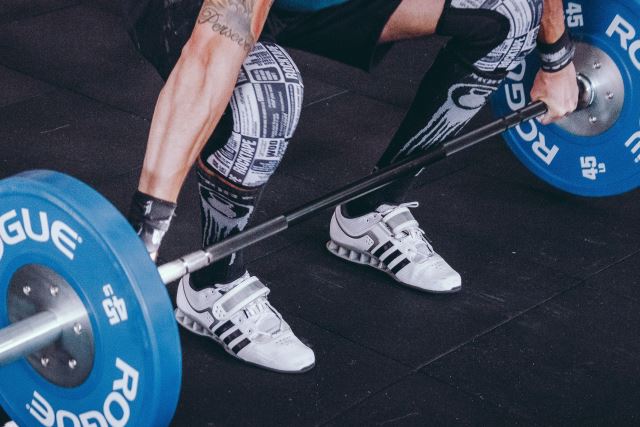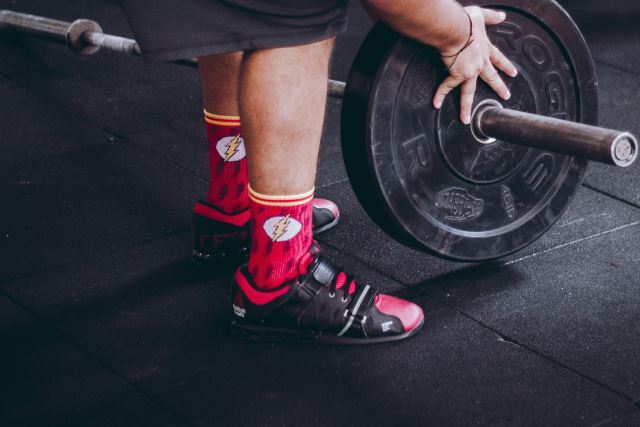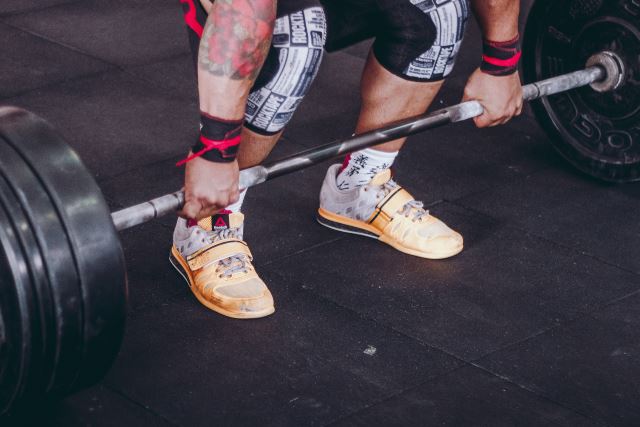
Weightlifting shoes seem to be getting more and more popular. Many in the fitness world invest in this type of footwear.
But they are not only limited to powerlifters, those that do heavy squats or Olympic lifting. It’s common to see CrossFit enthusiasts and amateur athletes exercise with elevated heels.
But the cool designs, fancy velcro straps over the laces, and stiff soles might not be the first thing you notice about them. It will likely be the price!
As with several other types of weightlifting equipment, lifting shoes can be beneficial for a certain type of workout… But for some people, they may just be for show or even serve as a crutch.
Advantages of Weightlifting Shoes
Shoes are often being updated to fit the majority of athletes’ needs while at the same time releasing new color schemes to give them some personality.
There are women’s weightlifting shoes with specific aesthetics and designs for female lifters.
But what we care about is performance!
Here are some benefits you can reap by using them during your strength training session. Check out our guide to the top rated weightlifting shoes for ideas.
1. Raised Heels
Weightlifting shoes are designed to have elevated heels, usually made from wood or hard plastic. This has several benefits.
Firstly, it enhances the wearer’s stability and balance so that they are more grounded and balanced during their workouts. Secondly, it maintains a proper posture, which is important when lifting heavier weights, and allows the wearer to get the full benefits from squats or deadlifts.
A more upright torso can be achieved for overhead squats and snatches, meaning that the shoulders stay in a more comfortable position.
Try out what it might feel like by doing some squats, clean and jerk, snatches or front squats with your heels on some plates
There is a varied range of heel elevation from shoe to shoe. So that they can match the postures and body types of different people. The elevated heel height can be extremely helpful during compound movements and Olympic lifts.
They help to ensure a successful lift by assisting with maintaining a good posture and reducing the required ankle mobility and tension on the Achilles tendon. They can also be particularly useful if you have a hard time with ankle dorsiflexion. A heel lift helps to maintain proper form and more utilization of the quadriceps, leading to a heavier lift.
So, the best course of action is to invest your time in finding the right elevation that helps you maintain your leverage and ease the lift in your power position.
Try on the shoes and get the one that makes you feel balanced and comfortable at your lowest squat posture. Also, keep in mind that longer femurs will require a higher heel elevation.
2. Enhanced Agility
True weight-lifting shoes have a firm base that provides ample support and balance at your knees, hip, and ankle. This, in turn, helps with improved mobility, making you agile and swift in your movements.
Enhancing this range of motion can directly benefit the strength and maintenance of posture. You need to pay attention to these details while picking out the right fit. Footwear makes you achieve your power positions easily without limiting any movement is the right one for you.

3. Firm Sole
You will have a solid base to support your lower body. A good Olympic weightlifting shoe limits the chances of getting hurt or pulling a muscle by providing a firm stable surface and increasing power transfer to the floor.
The use of solid soles and durable materials ensures that your feet are kept in place without your toes moving over the side helping your balance during a high-volume lift.
Avoid wearing shoes for lifting that have a soft rubber sole. The shoe that fits you correctly, will not be rocking at the base or have any instability when under a heavy load. It is the same rule as for running shoes. The Adidas Powerlift 3 is a great example of a shoe with a firm and wide base.
4. Ankle Support
The material of lifting shoes is either rubber or leather with what might seem like a kind of plastic coating. They are specifically engineered this way to provide additional foot and ankle support.
Many powerlifting shoes also have an added metatarsal strap or two over the laces and midfoot to further improve ankle support, better lateral stability and keep the foot in place.
5. Safety
Whenever we consider any sports gear, one of our main goals should be to reduce injuries. There is an increased risk when it comes to complex movements in strength sports and heavy lifts. This is especially true with compound activities.
A flat shoe that provides you with a solid base and support is directly reducing these risks.
6. Your Personal Touch
You can stand out and add personality to your lifts by finding unique color schemes and shoe designs to fit your needs and taste!
What to look for
While trying on the shoe, look for the one with an elevation that is fit for your body type and height. Try to take a short walk with it to be confident in its level of balance, support, and heel lift. It might not feel very comfortable at the start, especially if you are new to weightlifting. With time, you will get used to landing on a hard surface provided by these shoes.

Don’t go for cheaper options as they are often missing some support features (e.g at the ankles) and may result in quicker wear and tear or cause injuries.
By investing just a little bit more money, you can find a pair that can last many years. Finally, go for a shoe that makes you feel great when you try them on! It should complement your body, personality, and posture.
Are Weightlifting Shoes Worth The Money?
The best competitive lifters and strength athletes in the world can be seen wearing a pair of Nike Romaleos or Reebok Nanos.
Buts as their names suggest these shoes are only good for those who are enrolled in heavy weight lifting sessions and are pretty serious about building muscle mass and getting stronger. For casual CrossFitters or novice lifters, they may not be the best choice and won’t make a huge difference.
If you do a lot of wide stance squatting, staying with a flat shoe like normal sneakers or Chuck Taylor Converse are a better option.
If you are simply looking for a strong base to carry out routine workouts, your normal training shoes or sneakers will probably work just fine.
Also, many athletes have grown accustomed to lifting barefoot. But it’s exceedingly difficult to adjust into weightlifting shoes once you’ve found your balance and agility without them.
The Downsides
Firstly, and most importantly, there are many good shoe models that are easy on the pocket.
If you are a casual weightlifter on a budget, then you can do well without these shoes. Just like you can be fine without using weightlifting belts, wrist wraps, and knee sleeves. Some weightlifting and squatting movements can be accomplished just as well with minimalist footwear or crossover shoes.
Also, some people can find powerlifting shoes too stiff and difficult to adjust to. These shoes can only enhance your balance and posture, not provide it from scratch.
If your form, flexibility, and mobility are what’s keeping you down, you need to work on that rather than investing in a pair of Olympic weightlifting shoes as they can further worsen the problem instead of providing a quick fix.
They can sometimes also mask certain mobility issues and can limit your performance. This can make it difficult to locate the problems and improve on them. They also lack versatility in some cases as they are thick and bulky and sometimes won’t allow you to switch between different exercises as fast as you might like to.
So, to conclude, weightlifting shoes are good, but they are not for everyone. The key is finding the right type and knowing your own strengths and limits when making a choice.
Leave A Comment